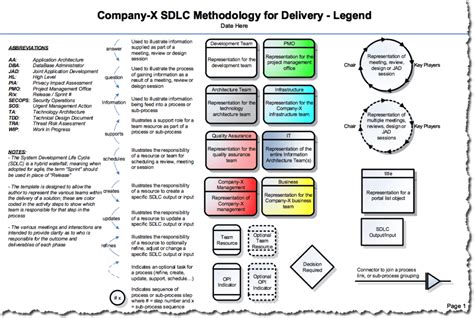The Software Development Life Cycle (SDLC) is a crucial process for any organization that develops software. It encompasses the entire lifespan of a software product, from planning and development to deployment and maintenance. An effective SDLC ensures that software is delivered on time, within budget, and meets the required quality standards. To streamline this process, using templates can be incredibly beneficial. Templates provide a structured approach to managing projects, enabling teams to focus on the development process rather than getting bogged down in administrative tasks.
Why Use SDLC Templates?
Before diving into the templates, it's essential to understand why they're so valuable in the SDLC. Here are a few key reasons:
- Improved Efficiency: Templates standardize processes and reduce the time spent on project setup. This efficiency allows teams to focus more on development and less on the management of the project.
- Enhanced Consistency: Using templates ensures that all projects follow the same framework. This consistency makes it easier to track progress, identify issues, and ensure that all aspects of the project are properly addressed.
- Better Communication: Templates often include sections for detailing project requirements, timelines, and roles. This helps ensure that all stakeholders are on the same page, reducing misunderstandings and improving collaboration.
- Risk Reduction: With a structured approach, teams are less likely to overlook critical elements of the SDLC, reducing the risk of project failure.
10 Free SDLC Templates to Boost Your Project Management
Here are ten free SDLC templates that can significantly enhance your project management capabilities. Each template has its unique strengths and is suited to different aspects of the SDLC.
-
SDLC Project Plan Template:
- This template is designed to help you create a comprehensive project plan. It includes sections for project scope, timelines, milestones, and resource allocation.
-

-
Agile SDLC Template:
- Tailored for agile development methodologies, this template focuses on iterative development, continuous improvement, and flexibility.
-

-
SDLC Requirements Gathering Template:
- This template is crucial for the initial stages of a project. It helps in gathering and documenting all the requirements from stakeholders.
-

-
SDLC Testing Plan Template:
- Effective testing is a cornerstone of the SDLC. This template aids in planning and executing thorough testing strategies.
-

-
SDLC Deployment Plan Template:
- This template is designed to help teams prepare for the deployment of software. It covers planning, execution, and post-deployment review.
-

-
SDLC Project Status Report Template:
- For ongoing project management, this template helps in tracking project status, identifying issues, and planning next steps.
-

-
SDLC Risk Management Template:
- Identifying and mitigating risks is a critical part of the SDLC. This template provides a structured approach to risk management.
-

-
SDLC Project Closure Template:
- When a project is complete, this template helps in documenting lessons learned, evaluating project success, and formally closing the project.
-

-
SDLC Change Management Template:
- Managing changes during a project is inevitable. This template helps in assessing, approving, and implementing changes effectively.
-

-
SDLC Lessons Learned Template:
- Documenting lessons learned is crucial for continuous improvement. This template aids in capturing experiences and insights from a project.
-

Gallery of SDLC Templates





Implementing SDLC Templates for Success
While templates are incredibly useful, their effectiveness depends on how well they are implemented within the SDLC. Here are a few tips to ensure that you get the most out of your SDLC templates:
- Customization: Don’t be afraid to customize templates to fit the specific needs of your project or organization. This ensures that the template complements your existing processes rather than conflicting with them.
- Training: Make sure all team members understand the purpose and use of each template. This can be achieved through training sessions or by including instructions within the template itself.
- Consistency: Consistency is key. Ensure that all projects follow the same set of templates to maintain uniformity and make it easier to manage multiple projects simultaneously.
- Continuous Improvement: Regularly review and update your templates based on lessons learned from past projects. This helps in refining the templates and making them more effective over time.
By following these guidelines and incorporating SDLC templates into your project management strategy, you can significantly improve the efficiency, quality, and overall success of your software development projects.
Feel free to comment below, share this article with your network, or get in touch if you have any further questions about SDLC templates or their implementation.
